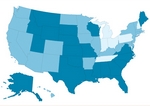government
Medicaid vaccination rates tied to flu shot pay levels
■ When physician payment goes up, the rate of full vaccinations in children also rises, a new study finds.
- WITH THIS STORY:
- » Not keeping up with costs
- » External links
Medicaid pay for administering pediatric influenza vaccines is associated with the percentage of poor children who are fully vaccinated, according to a recent study.
Increasing Medicaid flu vaccine administration fees by $10 -- from the typical state fee of $8 to the highest state rate of $18 -- was associated with overall vaccination rate increases of six to nine percentage points among poor children between 2005 and 2007, according to a study published in the November Pediatrics. Article authors compared state vaccination rates and state Medicaid fees for administering flu shots.
The percentage of poor children who received the full slate of shots recommended by the Centers for Disease Control and Prevention was 11.7% in 2006, 11.6% in 2007 and 18.8% in 2008. State rates vary widely, from 53% in Vermont to 4% in Iowa. Poor children are those in families earning less than the federal poverty level, or $18,310 for a family of three.
Most state Medicaid programs pay physicians less than their costs of giving flu shots to children, said Byung-Kwang Yoo, MD, PhD, assistant professor, Dept. of Community and Preventive Medicine at the University of Rochester Medical Center in New York. "This may create an obvious disincentive when physicians' offices lose money every time they give a flu shot, even though vaccines are provided for free."
For example, physician practices cover the expenses of storing the vaccines at specific temperatures, ordering and monitoring vaccine stocks, and insurance against the loss of vaccines.
Administering a single vaccine to a child younger than age 8 costs physicians $21.76 on average, according to Medicare relative value unit calculations by Centers for Medicare & Medicaid Services. Meanwhile, state-level physician Medicaid pay for giving flu shots ranged from $2 to $18 in 2007, with an average of $9.
However, the study found that low payment didn't always mean that vaccination rates were low.
For example, Colorado, Connecticut and Hawaii paid physicians $2 to administer pediatric flu shots in 2007 -- the lowest rate in the nation.
"That's pretty shocking," said Jillian Wood, executive director of the Connecticut Chapter of the American Academy of Pediatrics. Very few physicians recieve fees that cover their costs for giving vaccines, but Wood was surprised to hear that Connecticut was tied for the lowest fees..
Still, 44.1% of poor children in Colorado, 43.6% in Connecticut and 30.5% in Hawaii were fully vaccinated in 2008, Dr. Yoo said. These states have the 10th, 11th and 26th best rates in the country.
Wood said pediatricians vaccinate children -- even at a loss -- because it's part of their mission to prevent disease in the long run. "If we could allow physicians to break even on vaccines, it would make a huge difference in their business lives."
New York's Medicaid program paid $18 to give flu shots in 2007, the highest rate in the U.S. This is better than many private health plans, said Anne Francis, MD, past president of the AAP chapter for Upstate New York. Private plan vaccine administration fees ranged from $3 to $24, according to an article by University of Michigan researchers published in Pediatrics' December 2009 supplement.
But 35.5% of poor children in New York were fully vaccinated in 2008, the 20th-best rate in the country.
Dr. Francis said administering vaccines to children can be more difficult than giving them to adults. Additionally, some parents need counseling to dispel myths about vaccines they may have read on the Internet.
The health system reform law will improve Medicaid fees, at least temporarily. Medicaid vaccine administration fees for primary care physicians will increase to Medicare rates -- now at nearly $22 -- in 2013 and 2014. The federally funded hike is part of a larger increase for primary care services to Medicare rates in 2013 and 2014. Medicaid pay reverts to its previous levels in 2015.












